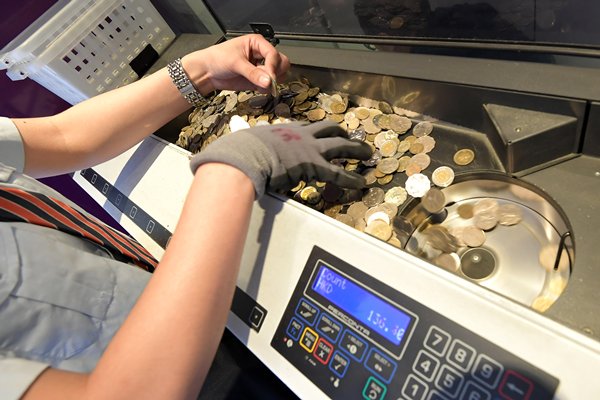Cashing In On Loose Change

Is your coin jar overflowing? Turn your coins into banknotes at the Monetary Authority’s coin carts and see how much money you can save by collecting loose change.
Mr Po and his son went to the coin cart with their toy safe. They saved $1,300 in six months.
“My kid puts the coins in the piggy bank for me. Many a little makes a mickle,” he said.
Mrs Tai brought a little bucket full of coins worth $3,080.
“We drop off a handful of coins when we get home every day, but we do not use them the next day.“
Collected coins are separated daily according to their denominations. Once the coins are transported to the bank, good quality ones go to retailers to be circulated in the market again.
Worn out, or damaged coins are returned to the authority which will send them to a mint in the UK or Canada to be melted and recycled.
Funny money
The Monetary Authority started the Coin Collection Programme in 2014. Since then, it has collected about 400 million coins.
But not all items received by the coin carts are legal tender, such as citizens’ false teeth and rings.
Some of the coins come from the most unexpected places.
Monetary Authority Head of Currency & Settlement Division Lydia Yip said they once received about 100,000 $1 coins from a charity.
The charity explained the coins were donated by people attending funerals, Ms Yip said.
It is a local tradition that mourners will receive an envelope which contains a $1 coin which has to be used after a funeral service.
Innovative idea
The concept of using coin carts to collect spare change was awarded the Best New Coin Innovation by the International Association of Currency Affairs.
Other central banks have expressed an interest in introducing similar services in their own countries.
“The coin carts bring convenience to the public. They also help save on minting costs due to the hoarding of coins,” said Ms Yip.
The authority monitors money flow monthly. If there are not enough coins in the market, they need to place an order with the mint up to nine months in advance. In 2017, 100 million 10-cent coins were minted.
“The demand for 10-cent coins is large because supermarkets and retailers price the commodities at prices like $49.9. That is why they need the 10-cent coins for change,” Ms Yip explained.
The authority will launch a new service schedule for its two coin carts from May 20 to July 28.
Citizens can convert their coins into banknotes free of charge, or top up their Octopus cards or e-wallet accounts at the coin carts which will travel to different districts.
Adaptive System Optimises Traffic Flow
In a bustling city like Hong Kong, waiting for traffic lights to change to green is an inevitable part of life, especi... Read more
Drone Sports Add To Low-altitude Buzz
Alongside the Government’s push to develop Hong Kong’s low-altitude economy, drone sports have been gaining in pop... Read more
Construction Robots Enhance Efficiency
For the Trunk Road T2 & Cha Kwo Ling Tunnel project, the Civil Engineering & Development Department has applie... Read more
HK's Smart Development Recognised
Hong Kong has placed significant emphasis on smart transformation and development in recent years – and its efforts ... Read more
Hotline Eases Carers' Burden
Mrs Lee, 74, and her 84-year-old husband are a doubleton elderly household relying on Comprehensive Social Security As... Read more
District Governance: Cameras Boost Security
Whether at busy intersections or tranquil street corners, Hong Kong has silent sentinels safeguarding citizens. Thr... Read more

